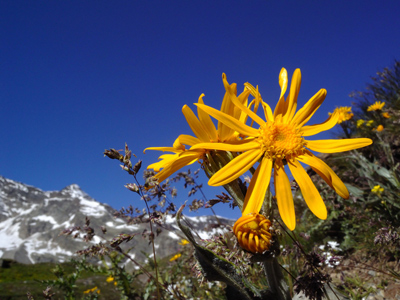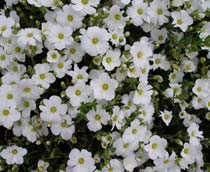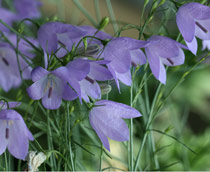
Ask the AI Tutor
Need help with Alpines - Alpines 1? Ask our AI Tutor!
AI Tutor - Lucy
Connecting with Tutor...
Please wait while we establish connection

Test your knowledge of alpines in this enjoyable quiz.
Alpines - Alpines 1
Very few keen gardeners can resist the charms of alpine plants. They come in a plethora of different forms, growth habits and flower colours and most are very forgiving of conditions that are less than perfect. On top of that they are petite and 'manageable' such that a dazzling array can be accommodated in a very small area.
Our quizzes aim to give you a taste for the vast range of alpines that are available. Don't forget to click on any of the pictures to expand them and take a closer look.
1 .
What is the common name for Anemone sylvestris?
Snow Anemone
Snowflake Anemone
Snowdrop Anemone
Winter Anemone
- The native habitat of this Anemone is deciduous woodland and therefore it is well suited to shaded areas of the garden.
- In a rock garden it will grow happily on a north facing slope.
- It does not enjoy wet conditions so make sure there is ample drainage.
- When happy it will spread very quickly so it might be necessary to trim it back now and again so that it doesn't get out of hand.
2 .
To which plant genus does the Mountain sandwort belong?
Arenaria
Dianthus
Saxifraga
Sedum
- The name of the species is montana.
- Produces a mass of sparkling white flowers in the spring.
- Grows to a maximum height of 20cm.
- Easy and cheap to grow from seed although a single packet will probably fill your entire garden!
- Requires well drained soil.
- Its shallow root system means that it is one of the first plants on the rockery to suffer in a drought.
- Watering might be necessary in a very dry summer.
3 .
This plant gets its common name from the belief that witches used the flower to make them turn into an animal. What animal?
Fox
Hare
Rabbit
Weasel
- The botanical name for the plant is Campanula rotundifolia.
- It grows wild throughout the UK and is particularly prevalent in Scotland.
- In the wild it propagates readily from seed but gardeners often have difficulty getting the tiny seeds to germinate.
- Existing clumps can be lifted and divided but don't be tempted to gather them from the wild - it is illegal unless you have permission from the landowner!
The common name for the plant is Harebell
4 .
From which continent does Pratia Pendunculata originate?
Africa
Asia
Australia
Europe
- Often known as the Blue star creeper.
- There are a number of different varieties with flower colours ranging from off-white to deep blue.
- Planted at about 30cms apart it soon forms a dense mat and is durable enough to be used as a lawn.
- Frequently used as a 'filler' between the spaces in crazy paving.
- Thrives in many different situations and is easy to grow from seed.
5 .
This is a Saxifraga. What is the meaning of the word in Latin?
Mountain follower
Spring announcer
Stone breaker
Water finder
- Latin name: Saxifraga oppositifolia.
- Sometimes called the Purple mountain Saxifraga.
- The plant relishes the cold and can be found growing in the wild as far north as any plant can survive.
- It is the county flower of County Londonderry in Northern Ireland and can be found both there and elsewhere growing wild in the UK.
- Comes into flower very early in the spring.
- Flower petals are edible.
Not the kind of stones that you find on a hillside but kidney stones when it is used medicinally!
6 .
'Snow in Summer' is the common name for the plant below. To which plant genus does it belong?
Centaurium
Centradenia
Cerastium
Cereus
- This species is C. Tomentosum.
- It has attractive 'woolly' foliage as well as a mass of summer flowers.
- The plant originated from alpine regions in northern Europe and it has now found its way into gardens all over the world.
- Very easy to grow from seed and will prosper in any temperature provided it is planted in well drained soil.
7 .
This is one of the easiest to grow of all Lewisias - what is it usually called?
Diskiyou lewisia
Friskiyou lewisia
Kiskiyou lewisia
Siskiyou lewisia
- The plant is sometimes called 'Cliff Maid' because of its ability to cling to rocky outcrops in its native USA.
- Flower stems can be up to 25cm long and each one carries up to 50 individual heads.
- Flowers can be orange, pink, white or yellow and often they are exquisitely veined.
- If they ever sit in a puddle of water they will quickly rot so it is important they they are planted in a free-draining area.
8 .
This variety of Columbine is often known by the region from which it comes. Which region is that?
Andes
Himalayas
Pyrenees
Rocky Mountains
- Aquilegias are also known as 'Granny's bonnet' because of the shape of the flowers.
- A range of pastel blues, pinks, yellows and whites are available.
- Often the flowers are bi-coloured.
- Some species grow tall enough to use as cut-flowers so make sure that you only buy dwarf growing forms if you want them for use in a rockery.
- It is a good idea to remove the seedheads to ensure that the parent plant does not get smothered by its children!
Usually known as the Rocky Mountain Columbine
9 .
Sedum species are noteworthy for being able to withstand what conditions?
Extremely cold
Extremely hot
Extremely dry
Extremely wet
- The Sedum in the picture is the species Sedum spurium and the variety 'Dragons Blood'.
- There are over 400 different species of Sedum and several of the species have many different varieties.
- Happy in both full sun or partial shade.
- Easy to grow from seed.
- In rockery areas that get badly neglected it is probable that this will be the last survivor!
Sedums are succulents and as such they are well-adapted to dry conditions
10 .
Helianthemums are most often known as what?
Rock Alyssun
Rock Creeper
Rock Lobelia
Rock Rose
- There are over 100 known species of Helianthemum but most of the ones seen in gardens belong to the species nummularium.
- Within this one species there are many varieties that have been bred specifically for use in gardens.
- A whole range of flower colours from brightest red to palest cream.
- Very hardy and enjoys dry conditions.
- Ideal plants for rockeries and sunny banks.
**Unlimited Quizzes Await You! 🚀**
Hey there, quiz champ! 🌟 You've already tackled today's free questions.
Ready for more?
Ready for more?
🔓 Unlock UNLIMITED Quizzes and challenge yourself every day. But that's
not all...
not all...
🔥 As a Subscriber you can join our thrilling "Daily Streak" against other
quizzers. Try to win a coveted spot on our Hall of Fame Page.
quizzers. Try to win a coveted spot on our Hall of Fame Page.
Don't miss out! Join us now and keep the fun rolling. 🎉
**Unlimited Quizzes Await You! 🚀**
Hey there, quiz champ! 🌟 You've already tackled today's free questions. Ready for more?
🔓 Unlock UNLIMITED Quizzes and challenge yourself every day. But that's not all...
🔥 As a Subscriber you can join our thrilling "Daily Streak" against other quizzers. Try to win a coveted spot on our Hall of Fame Page.
Don't miss out! Join us now and keep the fun rolling. 🎉
















